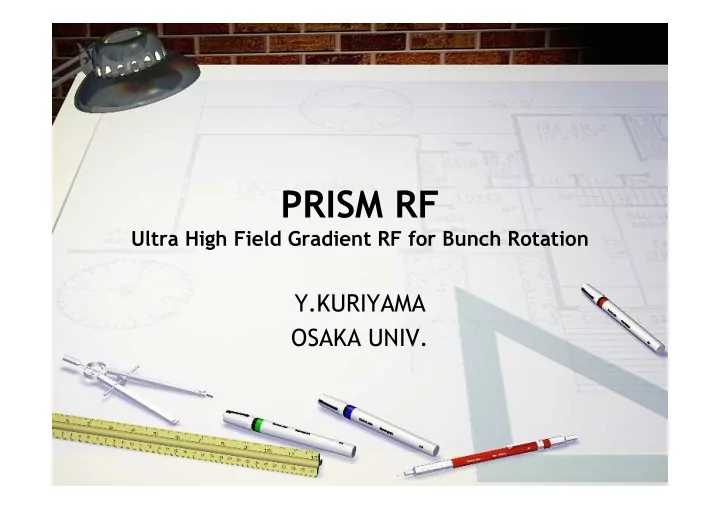

PRISM RF Ultra High Field Gradient RF for Bunch Rotation Y.KURIYAMA OSAKA UNIV.
Contents • Introduction of PRISM • PRISM RF Techniques • RF System R&D • Summary
Introduction of PRISM (1) Phase Rotated Intense Slow Muon Source ~105MeV e - • Search Search for Lepton Flavor Violation for Lepton Flavor Violation • B(µ-N → e-N) < 10 -18 • High Intensity High Intensity • Low E µ - Intence: 10 11~12 µ/sec Stop µ Experiment Beam Repetitaion: 100~1000Hz Muon Kiematic Energy: 20MeV(=68MeV/c) • High High Quality Quality • Muon Energy Spread: ±0.5~1.0MeV • High Purity Pion Contamination < 10 -18
Introduction of PRISM (2) • PRISM consists of – Pion Capture System – Pion Decay and Muon Transport System – Phase Rotation System
To Obtain a Muon Beam with Low Momentum Spread, • Several Ideas -Cooling in Synchrotron -Linac Option etc. But Short Life Time of Muon, • Solution: Bunch Rotation in a FFAG!
Phase Rotation • Accelerates Slow Muon and Decelerates Fast Muon by a RF Field in PRISM-FFAG ring. • Due to Muon Life Time, Bunch Rotation should be completed in 1µs(5turns). High Gradient RF System is required.
Spec. for PRISM RF • High Field Gradient (>200kV/m) – Muon has shrot life time • Low Frequency RF (4~5MHz) – Muons of low energy spread longitudinally – Difficulty to get High Voltage at Low Frequency • Saw tooth like RF shape – Low-Q cavity to allow Higher Harmonics – Magnetic Alloy Core (Finemet) is employed
High Field Gradient Proton Synchrotron RF System SATUNE 250 MIMAS CERN PSB Field Gradient (kV/m) 200 CERN PS !"#$% AGS 150 ISIS 100 KEK BSTR KEK PS 50 JKJ 50GeV MR JKJ 3GeV RCS 0 50GeV MR Upgrade 0 2 4 6 8 10 12 KEK-HGC Frequency (MHz) High Gap Voltage ( × 3) & Short Cavity ( × 2) Very High Gradient for very short moment (10ms)
To Obtain High Voltage at Low Frequency. • Magnetic Alloy – High Field Gradient ( -200kV/m) might be possible by an optimum design. • Ceramic Cavity – Very high field gradient might be possible. – Need R&D
Magnetic Cores for Cavity Ferrites Requirements for PRISM Magnetic Alloys B=V/ Ω S=400Gauss
MA Core for PRISM 1.7m
Parameters of MA Cavity Power tube 4CW100,000E, DC 33-37kV, 1.5 MW(peak for 10 m s) Field gradient 200- kV/cavity, -200kV/m Gaps/cavity 3-4 gaps, >50 kV/gap Length 33cm/gap 0.9k Ω /gap, Impedance # of cores 6 cores/gap (3.5cm core) Size of core 1.7m X 1.0m (1 m X 0.3m aperture) Cooling air cooling (Duty 0.1%)
Saw Tooth RF Shape ±5ns Muon width at given momentum RF 5MHz, 250kV/m Δ p/p=±3% Geant3 Simulation by A.Sato Not a sinusoidal but a saw tooth shape is needed.
PRISM RF R&D • FY2003: – Production of AMP, Power Supply etc. • FY2004: – AMP Commissioning by a test cavity @ � � RCNP, Osaka-U. 否 呟 Test Cavity – Design & production of 33 cm Cavity
Test RF System AMP Power Supply Cavity M-Experimental Hall, RCNP,Osaka-Univ. Core
RF System R&D • 43 kV/gap using 700 Ω test cavity • Design goal (60A RF current) of AMP was achieved. • 33 cm cavity will be 86.6kV >900 Ω : • Very compact design for AMP and APS.
PRISM Cavity Design AMP AMP Cavity Cavity APS Beam Pipe Beam Pipe APS 33cm Side View • 1 Gap will be produced in this FY04. By C. Ohmori, Y. Kuriyama
Summary • R&D for PRISM RF has been started in RCNP, Osaka-U. • AMP, PS, D-AMP and MA Cores have been produced. • AMP has been tested using a test cavity and achieved 43 kV at 5MHz. • Ultra High Field Gradient Cavity will be produced in FY2004. • Test of Ultra High Field Gradient in FY2005.
Recommend
More recommend